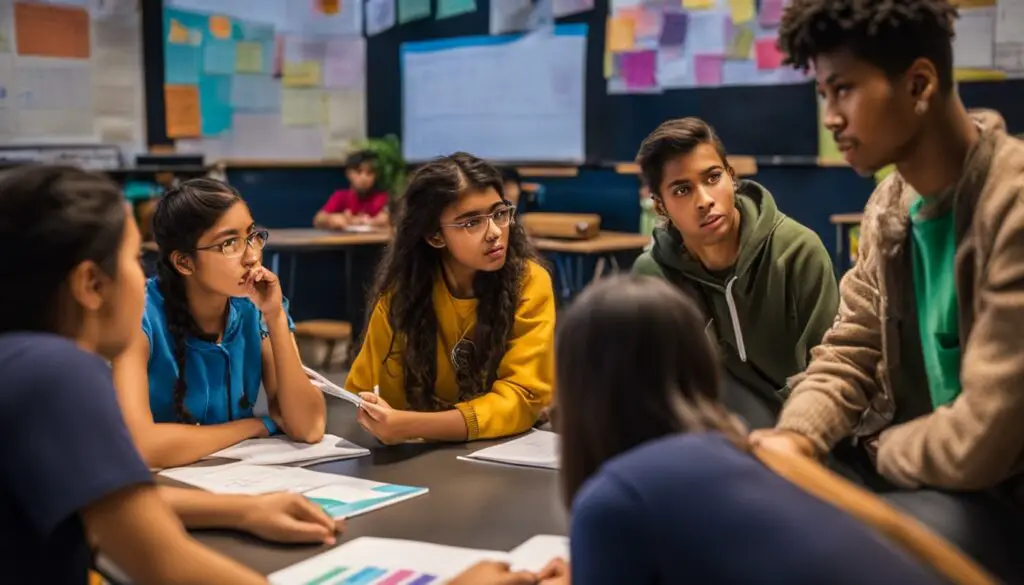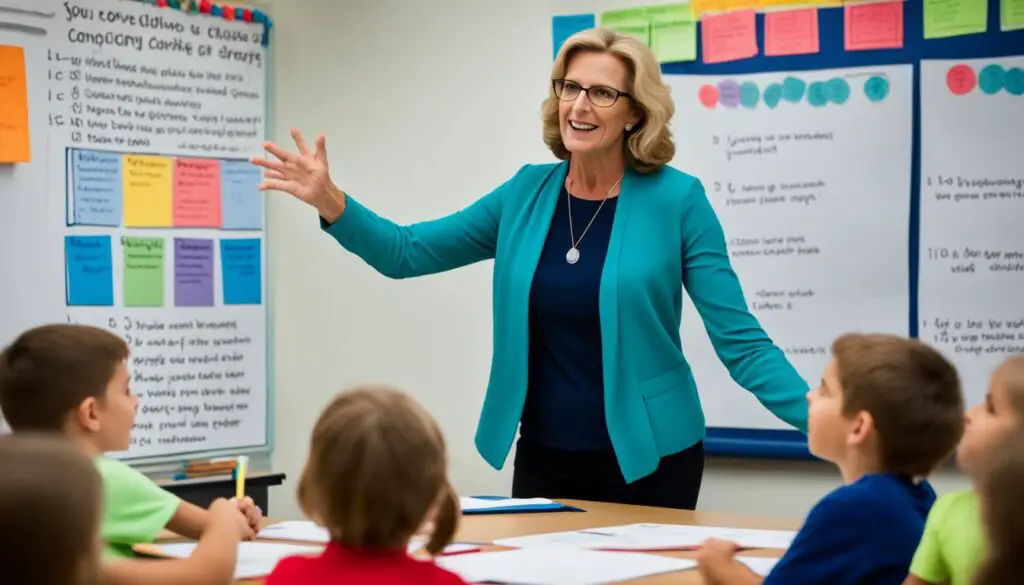Small-group learning is a powerful study tool. It can greatly improve the learning experience. It allows students to work together in groups of 3-6. This approach helps with active learning, thinking critically, and using what you learn in real-life.
This method not only helps students do better in school. It also makes their relationships with others and their teachers better. It even helps with feeling good about themselves.
Participating in small-group talks helps in many ways. It makes solving problems easier. It makes you understand the lesson better. It also helps you get better at talking with others and leading a group.
In these talks, students get to join in and share what they think. They can ask questions and work together with others. This makes learning a team effort.
There are many ways to use small-groups in class. Some examples include Turn-and-Talk and Think-Pair-Share. Using these methods makes students talk about what they are learning. It helps them see things from different angles and get a full picture of what they study.

Key Takeaways:
- Small-group discussions enhance the learning experience by promoting active engagement and critical thinking.
- Engaging in small-group discussions improves problem-solving skills and deepens understanding of the material.
- Implementing various small-group discussion strategies encourages collaboration and comprehensive learning.
- Small-group discussions can be conducted multiple times in a class session and count towards the class participation grade.
- Small-group learning fosters stronger relationships with classmates and faculty. It also promotes psychological well-being.
The Importance of Teaching Small Group Routine
To use small-group instruction well, teaching the routine is key. This includes what the group does, how loud they can be, and how they move. It helps make a good space for learning. Students know what’s expected of them in the discussions.
Each student in the group should have a job. These jobs like leading, noting key points, timing, and sharing findings, boost the group’s work. They learn to listen carefully and give helpful feedback. Everyone has a part to play, which makes the work better.
It’s also important to give tasks for students to do on their own. This keeps everyone learning even when not in a group. Tasks can include reading, looking things up, or finishing assignments. This way, all students stay active in learning.
Being open to changes is important in small groups. Teachers should move students around as needed. This makes sure everyone is in the right group for them. Every student’s learning needs are met this way.

| Benefits of Teaching Small Group Routine | Effective Classroom Management | Promotes Collaboration |
|---|---|---|
| Clear guidelines and expectations | Establishes a structured learning environment | Encourages active participation and teamwork |
| Develops important skills, such as listening and providing feedback | Enhances student engagement and focus | Fosters a sense of community in the classroom |
| Promotes accountability and responsibility | Creates opportunities for individualized instruction | Encourages diverse perspectives and ideas |
Strategies for Inclusive and Effective Small-Group Teaching
Creating an inclusive small-group teaching space needs thorough preparation. It’s important to consider each student’s cultural and educational background. Knowing if they’re confident in English, their schooling history, and what helps them learn is crucial. This info helps me adjust my teaching to match their needs better.
For a more successful class, I ask students to prepare before our meeting. This includes giving them questions and key terms related to our topic. This makes them more comfortable in small-group talks. It also means they come to class ready to share their thoughts. This step boosts our discussions and makes learning more fun.
Forming a tutorial room that is both safe and welcoming to all is my goal. I make sure every student knows they are important and respected. This encourages everyone to join in and work together better. Sharing their different cultural backgrounds during lessons adds great value. It not only makes our talk richer but makes the class environment better for all.
To wrap up, effective small-group teaching means being ready to understand and help all students. It involves sharing info they can study beforehand and making a place that welcomes everyone. It’s about working together and learning from each other’s cultures. Using these ideas has made big differences in my students’ interest, learning, and their school time.
FAQ
What is small-group learning?
Small-group learning means students work in teams of 3-6. It is used alongside regular classes. This method improves critical thinking, understanding, and applying lessons to real life.
What are the benefits of small-group learning?
There are many pluses to small-group learning. For starters, students grow their problem-solving skills and understand lessons better. They also become stronger socially and in leadership roles. Plus, their grades, relationships with peers, and teachers get better.
What are some strategies for implementing small-group discussions?
Key methods for small-group talks include Turn-and-Talk and Think-Pair-Share. Also useful are Peer Instruction, Jigsaw, and Pro-Con-Caveat Grids.
How can teachers create a conducive learning environment for small-group instruction?
To set up a good space for small groups, teachers should lay out clear rules. They need to explain the goals, the time involved, noise expectations, and movement during group work. They should give roles and show how students can work alone as well.
How can small-group teaching be made inclusive and effective?
For small groups to work well for everyone, teachers should know their students’ backgrounds. They should give preparation material before class. They must make sure the environment is welcoming for all and encourages sharing ideas. Avoiding cultural misunderstandings is key by valuing the diversity of the group.








